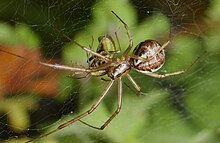|
Linyphia triangularis
Linyphia triangularis is a European species of spider in the family Linyphiidae first described by Carl Alexander Clerck in his 1758 Svenska Spindlar. DescriptionLinyphia triangularis grows up to 6 millimetres (0.24 in) long. The carapace is pale brown with darker markings along the edges and down the centre line; the opisthosoma has a coarsely serrate brown band against a white background, with further brown markings along the sides. The legs are greyish brown, and bear many long spines.[1] DistributionLinyphia triangularis is abundant throughout Europe.[1] It has been introduced to the U.S. state of Maine, having been first reported there on 28 August 1983 at Stover Corner.[2] It has been recorded from at least 15 of the state's 16 counties,[2] and is now abundant within Acadia National Park and some other coastal parts of the state.[3][4] EcologyLinyphia triangularis lives in a wide range of habitats, where it may be found among low bushes and vegetation. It spins a horizontal sheet-web, and rests on the underside of the web for its prey.[5] Adults are active in the late summer and autumn.[1][5] The prey are snared by "barrage lines" above the web, and fall onto the horizontal sheet, where they are killed by L. triangularis, but are not wrapped in silk.[1] References
External links
|
||||||||||||||||||||||||||||||
